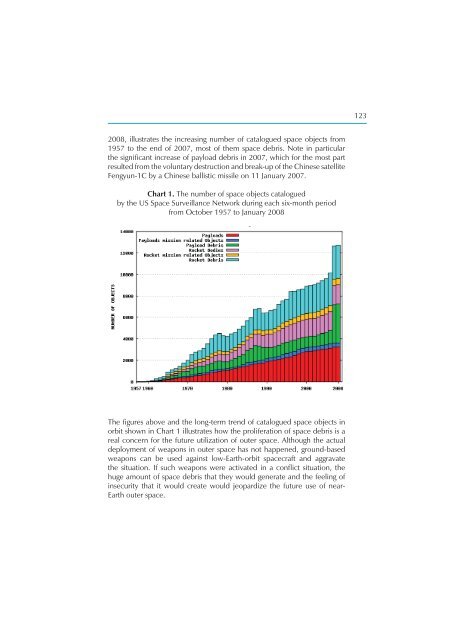Security in Space The Next Generation - UNIDIR
Security in Space The Next Generation - UNIDIR
Security in Space The Next Generation - UNIDIR
Create successful ePaper yourself
Turn your PDF publications into a flip-book with our unique Google optimized e-Paper software.
2008, illustrates the <strong>in</strong>creas<strong>in</strong>g number of catalogued space objects from<br />
1957 to the end of 2007, most of them space debris. Note <strong>in</strong> particular<br />
the signifi cant <strong>in</strong>crease of payload debris <strong>in</strong> 2007, which for the most part<br />
resulted from the voluntary destruction and break-up of the Ch<strong>in</strong>ese satellite<br />
Fengyun-1C by a Ch<strong>in</strong>ese ballistic missile on 11 January 2007.<br />
Chart 1. <strong>The</strong> number of space objects catalogued<br />
by the US <strong>Space</strong> Surveillance Network dur<strong>in</strong>g each six-month period<br />
from October 1957 to January 2008<br />
<strong>The</strong> fi gures above and the long-term trend of catalogued space objects <strong>in</strong><br />
orbit shown <strong>in</strong> Chart 1 illustrates how the proliferation of space debris is a<br />
real concern for the future utilization of outer space. Although the actual<br />
deployment of weapons <strong>in</strong> outer space has not happened, ground-based<br />
weapons can be used aga<strong>in</strong>st low-Earth-orbit spacecraft and aggravate<br />
the situation. If such weapons were activated <strong>in</strong> a confl ict situation, the<br />
huge amount of space debris that they would generate and the feel<strong>in</strong>g of<br />
<strong>in</strong>security that it would create would jeopardize the future use of near-<br />
Earth outer space.<br />
123








